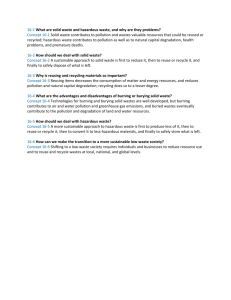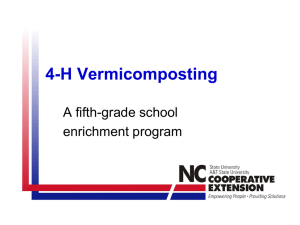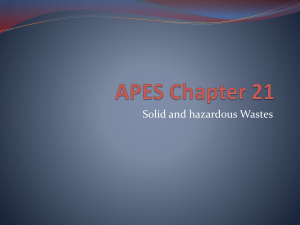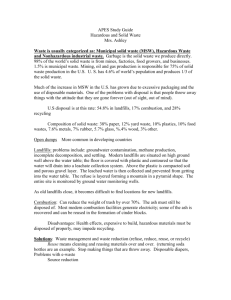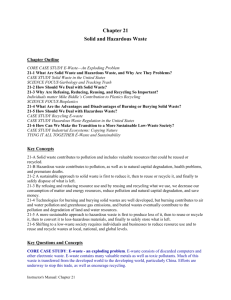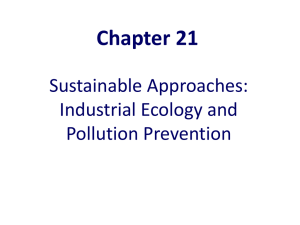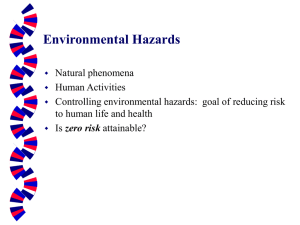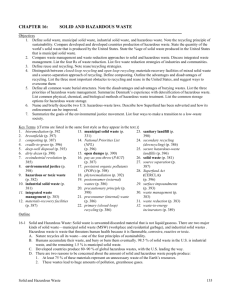13-1 What are the major population trends and problems in urban
advertisement
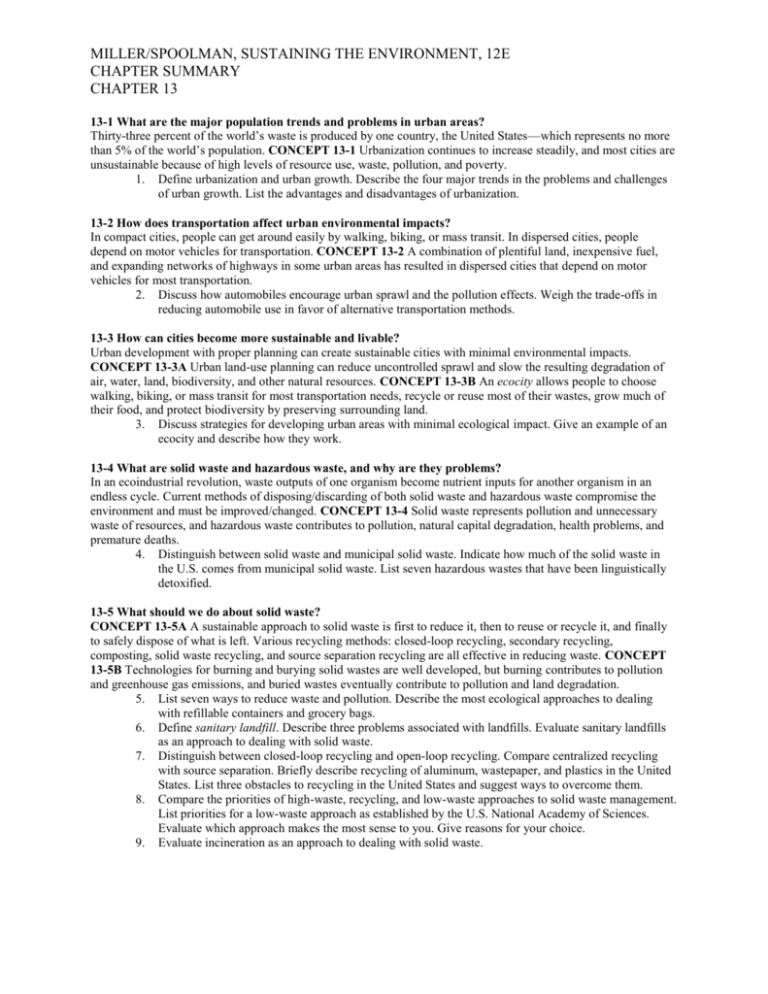
MILLER/SPOOLMAN, SUSTAINING THE ENVIRONMENT, 12E CHAPTER SUMMARY CHAPTER 13 13-1 What are the major population trends and problems in urban areas? Thirty-three percent of the world’s waste is produced by one country, the United States—which represents no more than 5% of the world’s population. CONCEPT 13-1 Urbanization continues to increase steadily, and most cities are unsustainable because of high levels of resource use, waste, pollution, and poverty. 1. Define urbanization and urban growth. Describe the four major trends in the problems and challenges of urban growth. List the advantages and disadvantages of urbanization. 13-2 How does transportation affect urban environmental impacts? In compact cities, people can get around easily by walking, biking, or mass transit. In dispersed cities, people depend on motor vehicles for transportation. CONCEPT 13-2 A combination of plentiful land, inexpensive fuel, and expanding networks of highways in some urban areas has resulted in dispersed cities that depend on motor vehicles for most transportation. 2. Discuss how automobiles encourage urban sprawl and the pollution effects. Weigh the trade-offs in reducing automobile use in favor of alternative transportation methods. 13-3 How can cities become more sustainable and livable? Urban development with proper planning can create sustainable cities with minimal environmental impacts. CONCEPT 13-3A Urban land-use planning can reduce uncontrolled sprawl and slow the resulting degradation of air, water, land, biodiversity, and other natural resources. CONCEPT 13-3B An ecocity allows people to choose walking, biking, or mass transit for most transportation needs, recycle or reuse most of their wastes, grow much of their food, and protect biodiversity by preserving surrounding land. 3. Discuss strategies for developing urban areas with minimal ecological impact. Give an example of an ecocity and describe how they work. 13-4 What are solid waste and hazardous waste, and why are they problems? In an ecoindustrial revolution, waste outputs of one organism become nutrient inputs for another organism in an endless cycle. Current methods of disposing/discarding of both solid waste and hazardous waste compromise the environment and must be improved/changed. CONCEPT 13-4 Solid waste represents pollution and unnecessary waste of resources, and hazardous waste contributes to pollution, natural capital degradation, health problems, and premature deaths. 4. Distinguish between solid waste and municipal solid waste. Indicate how much of the solid waste in the U.S. comes from municipal solid waste. List seven hazardous wastes that have been linguistically detoxified. 13-5 What should we do about solid waste? CONCEPT 13-5A A sustainable approach to solid waste is first to reduce it, then to reuse or recycle it, and finally to safely dispose of what is left. Various recycling methods: closed-loop recycling, secondary recycling, composting, solid waste recycling, and source separation recycling are all effective in reducing waste. CONCEPT 13-5B Technologies for burning and burying solid wastes are well developed, but burning contributes to pollution and greenhouse gas emissions, and buried wastes eventually contribute to pollution and land degradation. 5. List seven ways to reduce waste and pollution. Describe the most ecological approaches to dealing with refillable containers and grocery bags. 6. Define sanitary landfill. Describe three problems associated with landfills. Evaluate sanitary landfills as an approach to dealing with solid waste. 7. Distinguish between closed-loop recycling and open-loop recycling. Compare centralized recycling with source separation. Briefly describe recycling of aluminum, wastepaper, and plastics in the United States. List three obstacles to recycling in the United States and suggest ways to overcome them. 8. Compare the priorities of high-waste, recycling, and low-waste approaches to solid waste management. List priorities for a low-waste approach as established by the U.S. National Academy of Sciences. Evaluate which approach makes the most sense to you. Give reasons for your choice. 9. Evaluate incineration as an approach to dealing with solid waste. MILLER/SPOOLMAN, SUSTAINING THE ENVIRONMENT, 12E CHAPTER SUMMARY CHAPTER 13 13-6 How should we deal with hazardous waste? Waste management, waste reduction, and less usage of materials/energy are all needed to produce less waste and less pollution. CONCEPT 13-6 A sustainable approach to hazardous waste is first to produce less of it, then to reuse or recycle it, then to convert it to less hazardous materials, and finally, to safely store what is left. 10. Summarize difficulties with land disposal of hazardous wastes. Name and briefly describe two U.S. hazardous-waste laws. Describe how Superfund could be improved. 11. Describe bioremediation and its potential for dealing with hazardous waste in the future. 13-7 How can we make the transition to a more sustainable low-waste society? In moving toward a sustainable future, achieving a low-waste society and reducing hazardous waste, the issue of environmental injustice in deciding on the locations of hazardous treatment plants, incinerators, and landfills should be addressed from a local, national, and global perspective. CONCEPT 13-7 Shifting to a low-waste society requires individuals and businesses to reduce resource use and to reuse and recycle wastes at local, national, and global levels. 12. Describe environmental injustice and cite examples of such practices. 13. List the key principles that environmental scientists believe can be used to make the transition to a low-waste society. List three things individuals can do to reduce wastes.
